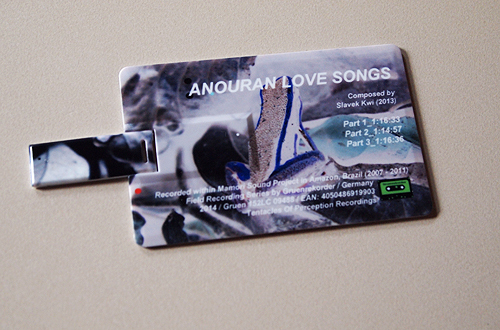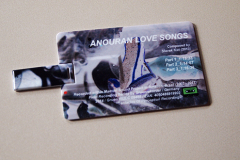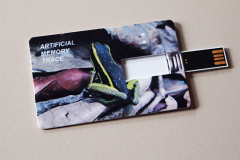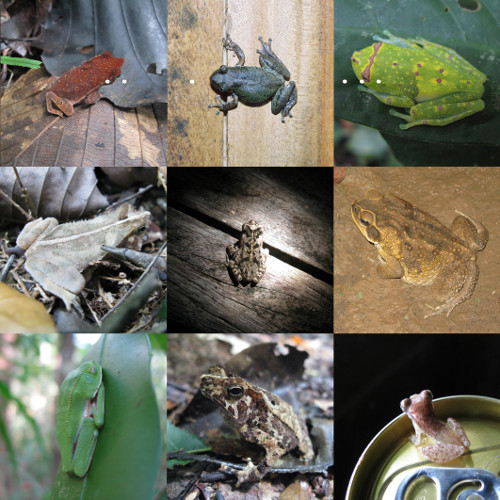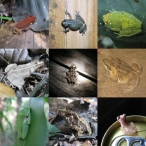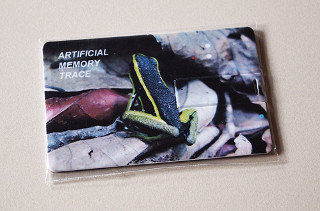
ANOURAN LOVE SONGS | ARTIFICIAL MEMORY TRACE
Gruen 152 | Triple album on usb flash card > [Sold Out]
Reviews
I have been fascinated by frogs since I can remember, either trying to catch them as a child or listening in awe to their haunting and mysterious songs. As a teenager I had terrariums at home with reptiles and frogs, many of them tropical. One of my first recordings was croaking toads, captured on a monophonic reel-to-reel tape recorder whilst I held the almost certainly scared toad in my palm, and in another recording making accompanying sounds with a rusted chain. Some years later I was listening to nocturnal choruses of frogs on the edge of a lake in Southern Czechie, blended with sounds from a camp-fire. Since then, during my wanderings across Europe, I have encountered incredible frog-song orchestras layered with varying sounds from different species and other insects. None of those orchestras were recorded – except in my mind – however the sounds have become imprinted as musical memories.
Many years after I traveled to the Amazon: the paradise of amphibians and insects. You can imagine my excitement. I was lucky enough to visit the Amazon several times in different locations, either on the black waters of Rio Negro or in the white waters of Mamori. Returning to the same place was very exciting and extremely interesting. During those years I collected many hours of recordings through different climatic conditions. I rarely saw the frogs I recorded due to the lush vegetation. After some while I didn’t even try to imagine how the frogs looked: all became this amazing dense and rather abstract soundscape. The variety of calls was astonishing: croaking, rubber-like, glass-like or tone ringing-like, barking, whistling bird-like, motor-like, clicking, ticking, trrrrr-like or squeaky-squidgy … and more, in every possible combination.
I found listening in a tropical rainforest environment a challenge; the mosquitoes and intense heat, along with other discomforts, interfered with concentration and made sitting still difficult. Most of the time it is actually better to listen from recordings – though this is obviously a very different experience.
It took a lot of time to roughly edit all my recordings from Amazon. I listened to everything many times; first in the car pre-selecting from bigger portions, then at home while looking after my little boys (who were adding their own vocal contributions to the overall soundscape). I took notes, making morphologic drawings, and only very slowly narrowed down the sequences. I was trying to imagine how I could share the experience on a smaller time-scale and yet keep the intensity of it. Selecting the best of the best sequences took a long time. I was searching for repeated patterns, sometimes overlapping cycles. I was looking for anomalies such as a frog suddenly „clearing his throat“ or trying to tune in to the global chorus, for similarities and differences simultaneously, regardless of chronological or any other order.
Finally I began to assemble fragments of various durations – each ranging between 30 sec and 10 min; there is in total 72 different fragments. I didn’t layer recordings and I didn’t use any processing or transformation. Everything is organized solely by the cut-up technique of editing. I attempted to create a sense of continuous – at moments dramatic – flow, sometimes interrupted by energetic differences between successive elements.
I am aware that each composition is long and we often do not have time to sit and listen for such lengths of time, so I have sub-divided each track in two, creating six episodes. I recommend listening with good quality speakers or headphones.
Anouran Love Songs is an extensive composition based on sound-ecosystems centered around unidentified tailless amphibians (frogs and toads) and insects (a variety of grasshoppers, leafhoppers, cicadas, crickets, various flying insects); sometimes featuring other animals, such as bats, birds, fish jumping out of water and sounds of weather.
Recorded around lakes of Mamori and Yuma in Amazon, Brazil, during years 2007-2011 and composed in 2013 in Ireland by Slavek Kwi employing only original non-transformed rainforest recordings. All sounds heard as recorded, there is no other manipulation than editing and recording.
Excerpts:
3 Tracks (228′06″)
Usb flash card (100 copies)
Field recordings were collected within Mamori Sound Project organized by Francisco Lopez and Asier Gogortza. Special thanks to the organizers, local crew and to all the participants whom I met during these years and who contributed to this amazing sound adventure.
Extended thanks to Roland and Lasse-Marc at Gruenrekorder for kind support.
Photos and design by Slavek Kwi.
USB Flash Drive contains 3x wav. audio-files (44.1kHz/16bit), 3x CD cover design (jpg), 1x pdf with information and illustrations (2 pages).
Field Recording Series by Gruenrekorder
Germany / 2014 / Gruen 152 / LC 09488 / IMRO / EAN: 4050486919903
Stephen Fruitman | Avant Music News
Oh, the places you´ll go! The things you´ll hear. Artificial Memory Trace trades as Slavek Kwi. He calls Ireland his home but one wonders if the Czech immigrant isn´t really at home wherever anything makes a sound, given the breadth and depth of his field recording art.
A boyhood fascination with frogs tadpoled into a huge fresco of Amazonian amphibia, recorded over the course of several years around lakes Mamori and Yuma in Brazil, sewn into seventy-two seamless fragments, stored on a USB flash card and going on for hours. Anouran Love Songs is a masterful Audubonian accomplishment and a remarkable extended listening experience. Copies are sold out at Gruenrekorder but still available through Kwi´s website.
link
Frans de Waard | VITAL WEEKLY
[…] I didn’t go over immediately to the release by Artificial Memory Trace, as I already knew that on this USB drive there would be three pieces of around 80 minutes each. Each is a full length CD and with the covers enclosed you are encouraged to copy them and threat them as such. I copied them to my hard drive so I could have a better playback. All three works deal with the sound of frogs, though not exclusively, as there is also „insects (a variety of grasshoppers, leafhoppers, cicadas, crickets, various flying insects); sometimes featuring other animals, such as bats, birds, fish jumping out of water and sounds of weather“, all of which were recorded during the years 2007-2011 around the lakes of Mamori and Yuma in Amazon, Brazil. I waited a few days to play this, as I didn’t want an overload of Slavek Kwi on a single day. This 240 minute trip into the jungle is also a bit much to go through in one go, as I experienced. Long stretches of frog sounds, that, a lot of times, sound like the buzzing of modular synthesizers, which is actually quite nice, and Kwi fading one into the next for the entire duration of a piece. Somehow it sounded a bit more ‚electrical‘ than the pieces on the double CD, and also a bit more collage-like, but maybe I was hallucinating after a while. I quite enjoyed it, even for this long afternoon of listening, reading, dozing off and coming back online. I am not that kind of guy who immediately thinks of holidays again, but a bit more sunshine might be nice.
link

